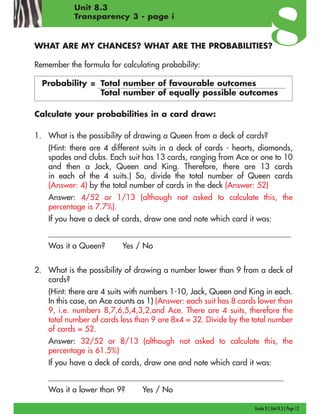
CALCULATE YOUR CHANCES WITH PROBABILITY
- 1. WHAT ARE MY CHANCES? WHAT ARE THE PROBABILITIES? Remember the formula for calculating probability: Probability = Total number of favourable outcomes Total number of equally possible outcomes Calculate your probabilities in a card draw: 1. What is the possibility of drawing a Queen from a deck of cards? (Hint: there are 4 different suits in a deck of cards - hearts, diamonds, spades and clubs. Each suit has 13 cards, ranging from Ace or one to 10 and then a Jack, Queen and King. Therefore, there are 13 cards in each of the 4 suits.) So, divide the total number of Queen cards (Answer: 4) by the total number of cards in the deck (Answer: 52) Answer: 4/52 or 1/13 (although not asked to calculate this, the percentage is 7.7%). If you have a deck of cards, draw one and note which card it was: ______________________________________________________________________________________________ Was it a Queen? Yes / No 2. What is the possibility of drawing a number lower than 9 from a deck of cards? (Hint: there are 4 suits with numbers 1-10, Jack, Queen and King in each. In this case, an Ace counts as 1) (Answer: each suit has 8 cards lower than 9, i.e. numbers 8,7,6,5,4,3,2,and Ace. There are 4 suits, therefore the total number of cards less than 9 are 8x4 = 32. Divide by the total number of cards = 52. Answer: 32/52 or 8/13 (although not asked to calculate this, the percentage is 61.5%) If you have a deck of cards, draw one and note which card it was: ___________________________________________________________________________________________ Was it a lower than 9? Yes / No Grade 8 | Unit 8.3 | Page 12 Unit 8.3 Transparency 3 - page i
- 2. Calculate the probabilities in a Lotto draw: 3. In a Lotto game you choose 6 numbers from 1-49. The total number of combinations of winning the 1st prize (of getting all 6 numbers) is :49 x 49 x 49 x 49 x 49 x 49 (or 496 ). The probability of winning first prize is 1 in 14 million! Therefore, there a good chance you could win 1st prize. True or false? (Answer: False!) 4. In a Lotto draw, you stand a better chance (i.e. a higher probability) of winning if you: a) chose numbers that have not been in the previous week's winning numbers. (Answer: False) b) just choosing the numbers 1,2,3,4,5,6 every time? True or false? (Answer: False. The process of selecting the numbers in a Lotto draw is totally random. That means there is no pattern, no connection between the numbers chosen or between the previous weeks' draws and the current one. Each of the 49 numbers has an equal chance of being drawn for each of the 6 slots. You therefore stand the same chance of winning if you chose 1,2,3,4,5,6 every week or 13,1,8,27,33,46 every week, or some combination based on birthdays, or any other combination of six numbers.) Calculate the probability in everyday occurrences: 5. Eighteen athletes with numbers 1 to 18 are running in the school race. The probability that the athlete numbered 7 will win is 1/18. True or false? (Answer: False. Running a race is not a random event. It is determined largely by skill and training. Of course, luck, as in all matters of life, can also play a part, for example if the fastest runner happens to be suffering from a bad cold that day.) 6. A couple has 3 daughters. If they have another baby it is likely to be a boy because 4-girl families are uncommon. True or false? Grade 8 | Unit 8.3 | Page 13 Transparency 3 - page ii
- 3. Answer: False. It is true that 4-girl families are uncommon, but in general having had a boy or girl previously has no influence on the gender of the next child, i.e., we assume that births are independent events. Actually, this isn't entirely accurate. The true probability is not exactly 50/50 due to rates of conception, miscarriages, and other environmental and physiological factors. A boy is more likely to be born (with a probability of 51.21%) than a girl (with a probability of 48.79%). 7. There are 26 letters in the English alphabet. If I select a letter at random from the page of an English novel, the probability that it will be an “e” is 1/26. True or false? Answer: False. As any Scrabble player knows, there are some letters (like vowels) that appear much more often than other letters (like x or y). 8. Elizabeth doesn't know the answer to a 4-answer multiple choice question. She is going to guess a, b, c or d. The probability that she will guess incorrectly is 3/4. True or false? Answer: True. Grade 8 | Unit 8.3 | Page 14 Transparency 3 - page iii